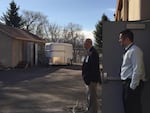
Pendleton Superintendent Jon Peterson (right) and Pendleton High School principal Dan Greenough look over a storage lot next to the high school. It used to be full of student projects. With the wood shop closed, there's little here.
Rob Manning / OPB
This story is part of the NPR reporting project “School Money,” a nationwide collaboration between NPR’s Ed Team and 20 member station reporters exploring how states pay for their public schools and why many are failing to meet the needs of their most vulnerable students.
If there's one lesson Oregonians, and the nation, can learn from the passage of Measure 5, it's this: you can't improve school funding with a tax cut.
Measure 5 was an initiative passed in November 1990 to rein in rising property taxes. Proponents argued the measure wouldn't harm public schools and could even help struggling rural schools by forcing the state to spread out income tax money collected from wealthier parts of Oregon.
But many rural schools, like those in Pendleton High School, did not see a benefit.
On a recent spring afternoon, 30 students had goggles over their eyes and a layer of sawdust on their shirts as they ran powersanders and saws in the wood shop at Sunridge Middle School. Eighth grader Kristie Anderson was helping out the teacher as an aide. She was looking at student projects and grabbing supplies while machines hummed all around her.
Anderson is a little disappointed she can't take wood shop next year when she goes to Pendleton High.
"There's a lot of different opportunities at the high school, but it would be nice to have a wood shop at the high school, too," she said, looking over the powersaws and sanders in the middle school shop.

Eighth grade student Kristie Anderson stands in the wood shop at Sunridge Middle School in Pendleton.
Rob Manning / OPB
The high school’s wood shop was a victim, years ago, of Measure 5.
Measure 5 passed in 1990 after proponents had tried, and failed, repeatedly to get voter approval of similar measures.
Retired Oregon State University political science professor Bill Lunch is one of Oregon's leading scholars on Measure 5. Lunch spent countless hours in Salem tracking the property tax debate.
Lunch said two things changed in 1990 that helped the anti-tax crusade: the proponents softened their anti-government rhetoric, and strong economic growth in the Portland area was pushing up property values and taxes.
"That drove many voters who had previously voted against these property tax limitation measures, to vote in favor of them in 1990," Lunch said.
The impact of Measure 5 was not immediate and wasn't uniform across Oregon.
For instance, the promise of better funding in parts of rural Oregon? It might not have happened in Pendleton, but it did in other parts of eastern Oregon.
Jerry McMichael works in the engineering program at Blue Mountain Community College in Pendleton. Twenty five years ago, McMichael taught in the Umatilla School District. He said the low-income, rural district always struggled with its budget, and that often meant under-paying teachers.

Students use power sanders in the Sunridge Middle School wood shop, in Pendleton.
Rob Manning / OPB
"Up until that time, we were known as a training ground for the districts around us, because there just wasn't the money to match their salaries," McMichael said.
Measure 5 put money in teachers' pockets, McMichael said, and kept young educators from leaving Umatilla for richer pastures.
The Oregon Department of Education did an analysis of school funding at OPB's request. ODE concluded that the variability from district-to-district varies far less now than it did 25 years ago, before Measure 5 changed the funding equation.
School supporters will argue that few districts were lifted up and far more, especially urban and suburban districts, saw their funding pushed down.
But one thing happened for all schools in Oregon: it made funding much more volatile.
That's because the money meant to make up for lost property taxes came, instead, from income tax. And as any economist will tell you, income tax revenue fluctuates more than property taxes in good times and bad.
School administrators and advocates say the good years never seem to make up for the bad. Otto Schell is a lobbyist with the Oregon PTA, and only knows school funding in the state in the post-Measure 5 era.
"I believe that people thought they could have it all, and the reality is, we can't," Schell said.

Pendleton High School briefly ran an aquaculture program to prepare students to work in the fisheries industry. It was eliminated amid budget cuts and the old aquaculture room is now storage. One of the old fish tanks is on the floor, full of cardboard boxes.
Rob Manning / OPB
At least not under the limits of Measure 5 and the spending patterns in Salem. Legislators tweaked Measure 5, and more measures appeared before voters - 47 and 50 - aimed again at Oregon's property taxes and funding for government services.
In the wake of Measure 5, the call from school advocates has been increasingly for "adequate" and "stable" funding - to counteract the roller-coaster.
In 2000, Oregon officials took two steps to answer those calls.
First, they set up something called the Quality Education Commission to determine just how much money the schools really needed. The conclusion? More. A lot more.
The second step was to send voters another ballot measure, sort of the state's answer to Measure 5.
If the effect of Measure 5 was to put most control over school funding in the hands of state legislators, the goal of 2000's Ballot Measure 1 was to ensure those lawmakers delivered the money that the Quality Education Commission found schools needed.
The measure passed. But it didn't actually force the sea change in funding that advocates envisioned.
Year after year, legislators continued to fund schools at amounts that continued to rise and fall with what the economy delivered through income taxes. And year after year, the Quality Education Commission published reports showing how inadequate the spending was.
Many school administrators have stories like Superintendent Jon Peterson's in Pendleton - that budget declines cost students opportunities.
Peterson looks around what used to be the high school wood shop.
"Hopefully within the next few years, we'll see this shop area buzzing again, but it's also likely it might not, the way things go," he said.
Peterson walked out the side door of the shop to an open, paved area. Years ago, there would be student shop projects stacked up all over. Students built a wooden shed that still stands here.
Administrators have tried to start programs under the unpredictable circumstances, sometimes only to cut those programs soon after. That was also the case at Pendleton High.
In another part of the sprawling eastern Oregon high school, one wing is dedicated to agricultural science. It used to have a few teachers, and now has just one.
Peterson opened the door off that teacher's classroom to what looks like a big storage area. There are empty fish tanks, plastic storage bins, cardboard boxes. When state funding was good, Pendleton launched a fisheries program in this room.
"So we were raising fish and growing plants, and now this is storage, what you're seeing here," Peterson said. "It ended quickly, just kind of after we got it going."
Peterson remembered times the school had to cut programs in the middle of a school year, because of a sudden economic downturn. Some school districts try to avoid such cuts by building up reserves in the good years, but that can be a hard sell for teachers and parents who want more direct classroom spending. Sometimes school districts have little choice but to lop days off the school calendar to balance suddenly shrinking budgets. The Hillsboro School District gained infamy by appearing in the New York Times when its schools closed three weeks early in 2003.
Oregon's funding situation had many legislators frustrated, too, as PTA lobbyist Otto Schell recalled. Schell remembered the Republican House speaker boiling down Oregon's school funding system to a single one-syllable word: "Nuts."
In 2006, school districts were fed up, and the Pendleton School District led a multi-district lawsuit against the state over school funding.
The case went all the way to the Oregon Supreme Court, where school advocates won.
Sort of.
The ruling said that the language of Ballot Measure 1 did require adequate funding of schools - but it gave lawmakers an out -- a loophole. If funding levels fell short of the mandated amount, legislators could write a report, instead of adequately funding education.
"It is a victory. It's a very odd victory, and that's the challenge," Schell said. "The remedy is a report, and that's not satisfactory at all."
Over the years, there have been lots of reports. But not once have lawmakers fully funded Oregon schools.
